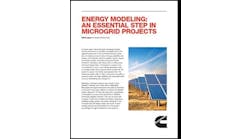The Federal Energy Regulatory Commission (FERC) ruled Monday that it will make energy resilience “a priority” — but not in the way U.S. Energy Secretary Rick Perry had requested.
Photo by momojung/Shutterstock.com
The commission rejected the energy secretary’s assertion that retirement of coal and nuclear plants threatens electric resilience. Instead FERC plans to look at broader challenges that may influence the reliable flow of energy in competitive wholesale markets, among them severe weather, physical and cyber attacks, accidents and fuel supply disruptions
FERC opened a new proceeding (Docket No. AD18-7-000) and ordered regional transmission organizations (RTOs) and independent system operators (ISOs) to provide information about bulk power resilience within 60 days. After that, others will have 30 days to respond to the RTO/ISOs filings.
Commissioners’ reasons
In a statement explaining why he rejected Perry’s proposal – which would have created subsidies for coal and nuclear — FERC Commissioner Richard Glick specifically cited the benefit of microgrids to ensure reliability.
Glick urged the RTOS/ISOs to carefully consider “how different generation technologies — both traditional technologies and newer, less widespread technologies — perform when faced with extreme weather, including droughts.”
“I also believe that it is important to consider the advantages that newer technologies, such as distributed energy resources, energy storage, and microgrids, may offer in addressing resilience challenges to the bulk power system,” Glick said.
He added that most power outages occur because of failures within the transmission and distribution system, and not because of a lack of power supply.
“There is no evidence in the record to suggest that temporarily delaying the retirement of uncompetitive coal and nuclear generators would meaningfully improve the resilience of the grid. Rather, the record demonstrates that, if a threat to grid resilience exists, the threat lies mostly with the transmission and distribution systems, where virtually all significant disruptions occur. It is, after all, those systems that have faced the most significant challenges during extreme weather events,” Glick said.
Richard Glick, FERC commissioner
Glick also described Perry’s proposal as a “multi-billion dollar bailout targeted at coal and nuclear generating facilities.”
In rejecting the coal and nuclear subsidies, FERC doubled down on its commitment to competitive markets. Commissioner Cheryl LaFleur called the proposed tariff for coal and nuclear a“far-reaching out-of-market approach” that would be “highly damaging to the ability of the market to meet customer needs.”
Freezing in place yesterday’s resources
“In effect, it sought to freeze yesterday’s resources in place indefinitely, rather than adapting resilience to the resources that the market is selecting today or toward which it is trending in the future,” LaFleur said.
Instead, FERC should guide grid operators to pursue resiliency within a system “that is likely to be cleaner, more dynamic, in some instances more distributed, and deployed by an efficient market for the benefit of customers,” LaFleur said.
Commissioner Neil Chatterjee also voted to reject Perry’s proposal and open the new docket — but with some reservations.
Chatterjee expressed concern about the “staggering” change the grid is undergoing, noting that between 2014 and 2015 alone, the U.S. added about 15,800 MW of natural gas, 13,000 MW of wind, 6,200 MW of utility scale solar photovoltaic, and 3,600 MW of distributed solar. Meanwhile, nearly 42,000 MW of synchronous generating capacity (coal, nuclear, and natural gas) retired between 2011 and 2014. An additional seven nuclear units, representing 10,500 MW, are set to retire by 2025.
He said it would have been prudent for FERC to consider interim tariffs for power plants that offer resilience but are at risk of retirement.
“I also believe that it is important to consider the advantages that newer technologies, such as distributed energy resources, energy storage, and microgrids may offer in addressing resilience…” — Richard Glick, FERC commissioner
Defining resilience
Microgrid advocates have been carefully watching the proceeding because resilience is an important benefit of the technology, one they say should be monetized in energy markets or transactions to reveal the true value of microgrids.
But the discussion gets bogged down by disagreements about the definition of resiliency. FERC attempted to overcome this problem by ascribing its own meaning to the term. In a broad interpretation, FERC defined resiliency as: “The ability to withstand and reduce the magnitude and/or duration of disruptive events, which includes the capability to anticipate, absorb, adapt to, and/or rapidly recover from such an event.”
Where oil and solar mix
Perry’s proposal had provoked an outpouring of objections from companies and organizations that saw it as skewing of markets against decentralized energy, natural gas and renewables.
Those same organization praised yesterday’s action by FERC.
“The portfolio of currently available clean energy technologies and services in the energy efficiency, natural gas and renewable energy sectors – working with energy storage, demand response and microgrids, among other technologies and services – is meeting the needs of the grid affordably and reliably today and can meet the needs of an evolving electric grid into the future,” said Lisa Jacobson, president of the Business Council for Sustainable Energy.
A coalition of organizations that represent such diverse fuels as solar, wind, oil, energy storage and natural gas also championed FERC’s action. In a joint statement the coalitions said it looks forward to “demonstrating the contribution of our industries to ensuring reliable power for all.”
The coalition includes the Advanced Energy Economy, American Council on Renewable Energy, American Petroleum Institute, American Wind Energy Association, Electric Power Supply Association, Energy Storage Association, Interstate Natural Gas Association of America, Natural Gas Supply Association and the Solar Energy Industries Association.
Kelly Speakes-Backman, CEO of the Energy Storage Association, described yesterday’s action as an “encouraging sign that FERC is serious about ensuring resilience of the bulk power system.”
She added: “By building a robust record of fact from the system operating bodies responsible for reliability and resilience, and by taking the important first step of defining both, FERC is rightly assuring that any actions taken will be holistic and effective.”
Join us at Microgrid 2018, where energy leaders will gather to discuss electric resilience.







